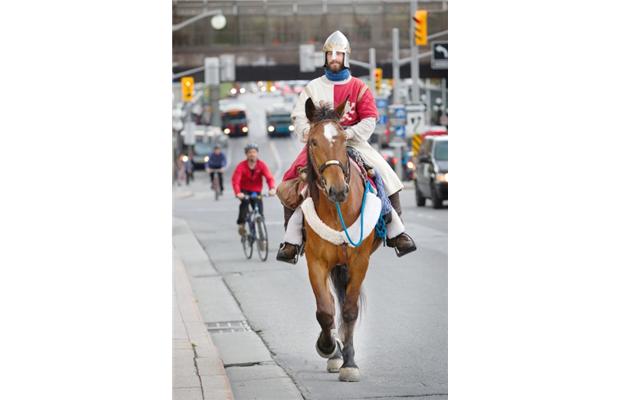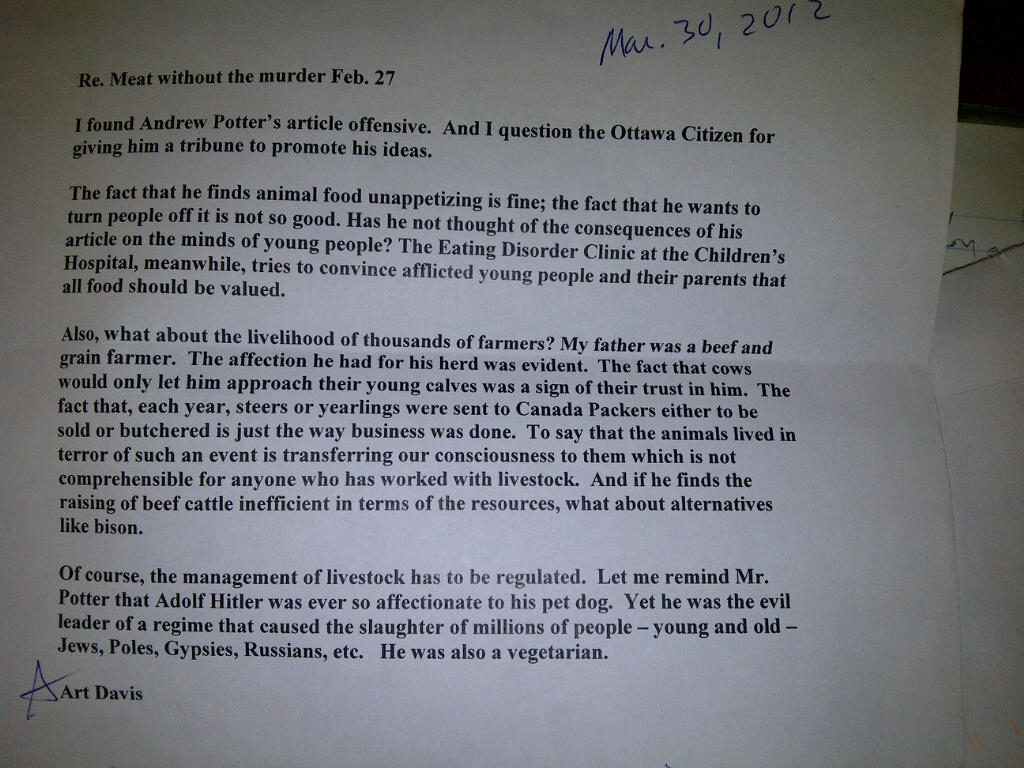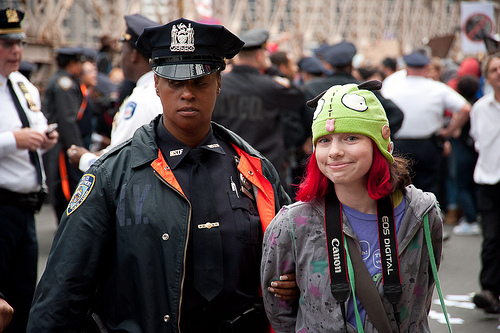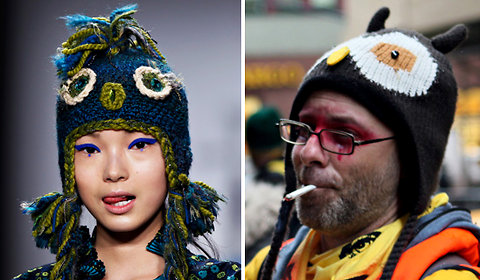Sir Lovesalot, or, the rise of conspicuous honour
 Thursday, May 10, 2012 at 01:25PM
Thursday, May 10, 2012 at 01:25PM

With his horse, Coeur-de-Lion, the French-Canadian Vincent Gabriel Kirouac is spending the summer dressed as a knight. Why?
“I’m crossing Canada on horseback dressed as a knight, to remind people of the values of long ago, such as devotion,” he said.
“All the values of the knight.”
The ancient code of chivalry is an interesting list of virtues, a mix of the anachronistic ("serve the liege lord in valour and faith"), the mildly sexist ("To respect the honour of women"), the ridiculously noble ("To despise pecuniary reward"), and the wonderfully sublime ("To persevere to the end in any enterprise begun"). For the most part, it is completely incomprensible to the modern mind.
When I give my authenticity spiel, at some point some one usually asks where I think the culture is going next. So we had conspicuous leisure, then conspicuous consumption, the conspicuous rebellion, then conspicuous authentiticy. What next? I usually try to weasel out of a serious answer ("Just like the present, but moreso" is my usualy reply). Or I suggest that if I really knew, I'd be investing in that thing and would soon be rich.
But if I had to bet, I'd say we are headed for a fairly reactionary period. I wouldn't be surprised to see a Neo-Victorian movement, for example, where a return to 19th century values amplifies the already-huge steampunk culture. The hipster-Christian trend is part of that, I think.
But perhaps something else is afoot: a return to pre-modern attitudes towards chivalry, honour, and loyalty, fed by the twin streams of relentless cultural nostalgia (and its obverse, irony) and the growing crisis of masculinity. I would put the Trudeau-Brazeau fight (and the remarkably complex set of responses to it) in this trend.
And then there is Vincent Gabriel Kirouac, knight-errant. If the public reaction to his -- ok I'll say it -- Quixotic journey across Canada is any indication, there's a niche here ready to be exploited. Dare we call it "conspicious honour"?
Conrad Black: Hipster arriviste?
 Tuesday, May 1, 2012 at 08:21PM
Tuesday, May 1, 2012 at 08:21PM Former news baron Conrad Black is expected to be released from his US prison later this week, and despite having given up his Canadian citizenship in order to accept an appointment to the British House of Lords, he has obtained a temporary resident permit from Canada's department of citizenship and immigration. This will allow him to remain in this country for one year, for starters.
I'm of at least two minds about this. From the late 1990s until his indictment in the United States in 2005, Black had very little in the way of good things to say about Canada. He made it clear he preferred the culture of Great Britain, the tax regime of the United States, and the companionship of a global wealthy elite to the people, policies, and politics of his home and native land.
He didn't just change his tune when he was incarcerated -- he switched genres entirely. The Canada's-a-socialist-dump dirge switched overnight to an upbeat pop number called "Canada Rocks!" Since 2005 Black has used the podium of his column in the National Post to praise Canada, its people, its laws, its former Liberal leaders, and its... animals.
The timing of it all is more than a little suspicious. I don't think it speaks super well of the man that he only started saying nice things about this place when it was clear that it was the only country where he might be even remotely welcome, but that he'd --oops -- gone and told his compatriots where they could shove their economy-class passport. I'm inclined to the view that the measure of a man is not how he acts when he needs the goodwill of others, but when he does not.
But Jon Kay, Black's editor at the National Post, has argued that Conrad Black is a genuinely changed man, that prison has given him an empathy for the unjustly accused and for his fellow man that he never had before. How sincere is any of this? I honestly don't know, but I'm willing to take Jon's word for it. People can change.
Not that it matters, since it isn't up to me. Conrad Black is coming home, and on the whole I think Canada will be the better for it. He invested more in journalism in this country when he owned the Southam chain than anyone has done since, and it has been my great privilege to work for and with journalists, editors, and publishers whose careers he made happen, directly and indirectly. Plus he's loads of fun and endlessly entertaining.
The only remaining question then is, where shall he live?
The assumption is that he'll go back to his pad in Toronto's ritzy Bridle Path. But I think it would be a mistake for him to go back to living, as he did for so long, amongst the elite and the out of touch. It would be a shame for him to lose contact with the common man for whose travails he has discovered such awareness and compassion.
Besides, isn't wanting to live amongst the high-powered and the high-priced precisely what got him into such trouble in the first place? His troubles with the law were in many ways a direct consequence of his enthusiasm for social climbing, in particular of his desire to be a peer (and later, Peer) of the crowd that Paul Fussell calls the "Top Out of Sight" class -- the billionaires and multi-millionaires who are so wealthy they can afford exclusive levels of privacy. You never see them, and they never see you.
Instead of aping the English upper crust, Black might have taken his lead from his fellow rich guy Richard Branson, who turned his whole personality into a global brand. But Lord Black isn't an exuberant adventure-seeker like Sir Richard. So even better, he might have picked up the gauntlet tossed down by seriously rich guys Bill Gates and Warren Buffett, and devoted his considerable genius and energies to charitable one-upmanship.
But Conrad Black never had remotely enough money to play in these leagues. Now he has even less, which is probably a blessing. What he really needs to do is jump into a pond where he can keep in touch with people who have no money and no real life prospects, while engaging his particular talent for status-seeking. That is, he needs to become a hipster.
Black is never going to look good in skinny jeans and a v-neck 70s t-shirt, but the spirit of Orson Wells that permeates Conrad's character could be leveraged into a mid-century Mad Men sort of cool that would be perfect for Montreal's Plateau. Better, given his Victorian-era vocabulary and a few tweaks to his wardrobe and Black could reinvent himself as a steampunk entrepreneur, selling carboys of science experiments out of a food truck in Ottawa's Hintonburg. But given how easily he managed to adopt the one-pantleg-rolled look of the prison yard, maybe his best bet would be to move into Toronto's gentrifying, but still ethnically complicated and economically downtrodden, Regent Park neighbourhood.
It doesn't really matter where he chooses to live, and with whom, as long as it isn't amongst the old tribe with its old values, the ones that got him into such trouble. Conrad Black has his country back: now all he needs is a people to keep him grounded.
 conrad black,
conrad black,  hipster in
hipster in  politics
politics Copenhagen Graffiti
 Thursday, April 26, 2012 at 08:57PM
Thursday, April 26, 2012 at 08:57PM
But there is one thing about Copenhagen that I found a bit jarring: It is easily the most aggressively graffiti'd city I've spent any significant time in. Virtually every building, facade, transit station, park bench, or pillar has been tagged, bombed, or stenciled, including the storefronts in the more chi-chi part of town. This isn't necessarily a problem: 'm a big fan of street art, and a some of the bigger pieces help underscore a neighbourhood's identity, like so:
And so it was into this seemingly welcoming environment that Shepard Fairey arrived last August for the opening of an exhibition of his work at a Copenhagen gallery. While in town, he swung by one of the most notorious vacant lots in the city -- Jagtvej 69, the site of a lefty squat at in the wonderfully multicultural Nørrebro district that was demolished by the city in 2007. Since then, the lot has become a sort of martyr of negative architecture, a sign of The Man's ongoing persecution of the counterculture. Here is the building right next door to the old squat:
On the side of a building facing the vacant site from the east (above), Fairey painted a mural that showed a dove in flight above the word "peace" and the number 69. The locals didn't seem to like the mural or its message. After the mural went up it was immediately defaced with "NO PEACE!" and "Go home Yankee hipster". A few days later, Fairey was beaten up outside a nightclub in Copenhagen's rather douchey meatpacking district (very similar look and feel to New York's) by someone who called him "Obama illuminati" and ordered him to "go back to America".
It really is an appalling work -- the street-art equivalent to John Lennon's ode to empty-headed peace-mongering, "Imagine". Fairey tried to make it better by trying to tidy up the work and make it cooler by adding a black helicopter to the bottom, but that only seemed to make the locals angrier. The thing continues to get vandalized, to the point where the bottom twenty feet are a riot of paint-bombed resentment. Here's how it looked when I was there last month:
The saddest part is that there is already plenty of excellent indigenous art on the buildings surrounding the vacant lot:
As a result, it isn't clear how Fairey thought he was helping, or what he thought he was adding. If anything, it looks like he was trying to keep his cred by piggybacking on the authentic anti-establishment politics of the Jagtvej 69 diehards.
But then again, it isn't clear just how authentic those politics ever were. A few doors down from the commune there was a McDonald's that used to get vandalised every night by anti-corporate lefty types. But someone was patronizing the joint, and it is significant that shortly after the building at Jagtvej 69 was knocked down, the McDonald's went out of business. There's a crappy little bakery there now.
 copenhagen,
copenhagen,  denmark,
denmark,  graffiti,
graffiti,  shepard fairey,
shepard fairey,  street art in
street art in  art
art "Then kablooie, they changed": How Coke lost its authenticity
 Wednesday, April 25, 2012 at 01:43PM
Wednesday, April 25, 2012 at 01:43PM Pop quiz: When did Coca-Cola stop being authentic?
Never, you might answer. After all, as the company's own promotional material puts it, Authentic Americana -- with all of the "happiness and uplift" that implies -- has been the core of the Coca-Cola brand ever since the first Coke was served at Jacob's pharmacy in Atlanta 126 years ago.
If you're a bit savvier, you might suppose that the day Coke stopped being authentic was the day it announced the introduction of New Coke. As it turns out, that was 17 years ago yestersday, and the CBC has posted the news story Ann Medina did a the time.
View the CBC story here.
It's hard to imagine now what a big deal the story was at the time, partly because it is hard to think of a contemporary parallel. Soft drinks, groceries, and other consumer-goods markets tend toward healthy competitive duopolies, while the inevitable network effects in the the tech and software industry tend to lead to successor monopolies. And it is hard to think of a contemporary product that has the myth and mystique of Coke's secret formula. (Any ideas? Send me an email).
Anyway, few new product launches have gone as badly. As this article from Fortune shows, a month after the launch of New Coke, Coca-Cola executives were still confident they had made the right decision.
Yet Pepsi knew that something fundamental had happened: it gave its employees the day off to celebrate what it saw as Coke's gaffe. As Pepsico's Roger Enrico put it: "These two products, Pepsi and Coke, have been going at it eyeball-to-eyeball. And in my view the other just blinked." Reinforcing success, Pepsi quickly came out with a devastating ad showing a young woman wondering why Coke had abandoned her. The ad was famously written in about thirty seconds and shot in one take, and starred the actress Kim Richards (who would go on to star in Meatballs II).
When I was in Denmark last month, I spent a day at the University of Southern Denmark at Odense in a workshop on authenticity and marketing. Over the course of the day, Soren Askegaard, a professor of marketing at the school, asked the question I posed at the very top. Most of us answered that Coke lost its authenticity when it brought in New Coke.
But as Soren pointed out, it wasn't the changing of the formula that undermined the authenticity of Coke's brand. After all, the product's formula, however secretive, had undergone plenty of changes over the years. No, the really bad move from a branding point of view was when they introduced a new product, a variant of the original, called "Coca-Cola Classic," on July 10, 1985.
Why is this signficant? Because that is the moment when Coca-Cola became a copy of itself. It was no longer Coca-Cola, it was "Coca-Cola" or -- just as bad -- "Coke Classic". Just as no true VIP ever goes into the "VIP Room" at a bar, nothing that calls itself "genuine", "famous" or "classic" is genuine, famous, or classic.
On July 10 1985, Coke ceased to be a living brand, evolving organically with the changing tastes and attitudes of America. With Coke Classic the brand was put in a museum, where it remains a simulacrum of the powerful brand it once was.
For those who are interested, here is a video of a conversation I had with Soren Askegaard the morning of our seminar:
 authenticity,
authenticity,  coca-cola,
coca-cola,  coke,
coke,  denmark,
denmark,  pepsi,
pepsi,  soren askegaard in
soren askegaard in  consumerism
consumerism Journalists who fell in the line of duty
 Wednesday, April 25, 2012 at 08:42AM
Wednesday, April 25, 2012 at 08:42AM In parliament yesterday, Canadian senator Joan Fraser rose "to bear witness to the more than 50 journalists and media workers who died in 2011 because they were journalists." She then made a short statement, and read out the names of media workers who fell in the line of duty. It is a depressingly long list.
Nearly half of the journalists were murdered outright. Others were killed in crossfire or combat, as they were doing their jobs. Others were killed on dangerous assignments of one sort or another covering demonstrations, riots, mobs and racial clashes.
They were: in Afghanistan, Ahmad Omaid Khpalwak and Farhad Taqaddosi; in Azerbaijan, Rafiq Tagi; in Bahrain, Zakariya Rashid Hassan al-Ashiri and Karim Fakhrawi; in Brazil, Edinaldo Filgueira, Luciano Leitão Pedrosa and Gelson Domingos da Silva; in the Dominican Republic, José Agustín Silvestre de los Santos; in Egypt, Ahmad Mohamed Mahmoud and Wael Mikhael; in Iraq, Muammar Khadir Abdelwahad, Sabah al-Bazi, Alwan al-Ghorabi, Hadi al-Mahdi and Mohamed al-Hamdani; in Ivory Coast, Sylvain Gagnetau Lago and Marcel Legré; in Libya, Ali Hassan al-Jaber, Mohammed al-Nabbous, Anton Hammerl, Tim Hetherington, Chris Hondros and Mohammed Shaglouf; in Mexico, Luis Emanuel Ruiz Carrillo, Maria Elizabeth Macías Castro, Noel López Olguín and Rodolfo Ochoa Moreno; in Nigeria, Zakariya Isa; in Pakistan: Nasrullah Khan Afridi, Wali Khan Babar, Asfandyar Khan, Shafiullah Khan, Javed Naseer Rind, Faisal Qureshi and Saleem Shahzad; in Panama, Darío Fernández Jaén; in Peru, Pedro Alfonso Flores Silva; in the Philippines, Romeo Olea and Gerardo Ortega; in Russia, Gadzhimurad Kamalov; in Somalia, Abdisalan Sheikh Hassan, Noramfaizul Mohd and Farah Hassan Sahal; in Syria, Ferzat Jarban and Basil al-Sayed; in Thailand, Phamon Phonphanit; in Tunisia, Lucas Mebrouk Dolega; and in Yemen, Jamal al-Sharaabi, Hassan al-Wadhaf and Fuad al-Shamri.
Every one of them died in the service of bringing the truth to the rest of us. They died, in the most profound sense, for us. This is our small way to bear witness to their sacrifice.
Fraser is the former editor-in-chief of the Montreal Gazette.
 Joan Fraser,
Joan Fraser,  Senate,
Senate,  journalism in
journalism in  politics
politics Getting to Denmark
 Tuesday, April 24, 2012 at 10:18PM
Tuesday, April 24, 2012 at 10:18PM
Thomas Kinkade and the Ideology of Natural Taste
 Saturday, April 7, 2012 at 05:31PM
Saturday, April 7, 2012 at 05:31PM Thomas Kinkade, "Painter of Light", artist to the masses, has died. In the Wikipedia entry for Kinkade, it says that in "Joe Heath and Andrew Potter's book The Rebel Sell: Why the Culture Can't Be Jammed, Kinkade's work is described as 'so awful it must be seen to be believed.'"
Sort of.
In our book The Rebel Sell, Joe and I used Kinkade's work to illustrate (and support) Bourdieu's critique of the ideology of natural taste, i.e., the view that aesthetic judgments are judgments of true properties of the artwork. Here's how we began:
Ever notice that the masses have incredibly bad taste? Admit it. Take a look at a painting by Thomas Kinkade ("Painter of Light"), the best-selling visual artist in the United States. His work is so awful it must be seen to be believed. Or go down to one of the discount furniture warehouses, the kind that are constantly advertising "no payment until 2037". Try to find a single piece that you would be willing to put in your living room. Or listen to an entire album by Kenny G, the best-selling intrumentalist in the world. Your typical urban sophisticate would find this experience not just unpleasant, but positively harrowing...
The popular view of aesthetic judgment is dominated by what sociologist Pierre Bourdieu calls "the ideology of natural taste." According to this view, the difference between beautiful and ugly, tasteful and vulgar, stylish and tacky, resides in the object. Bad art really is bad, it's just that only people with a certain background and education are able to recognize it as such. Yet, as Bourdieu points out, this ability to detect bad art is distributed in an almost miraculously class-specific fashion. In fact, only a tiny percentage of the population has it. And as Bourdieu documents quite exhaustively, this capacity is almost entirely concentrated among the high-status members in society. The lower classes uniformly love bad art, while the middle classes have resolutely "middle-brow" taste.
Anyone with an even moderately critical turn of mind can see the obvious explanation for this pattern...
So, we don't quite say that his work is "so awful that it must be seen to be believed", but that for people of a certain class, it certainly seems so. Millions of people, obviously, think otherwise.
 pierre bourdieu,
pierre bourdieu,  thomas kinkade in
thomas kinkade in  art
art "Let me remind Mr. Potter that Adolf Hitler was ever so affectionate to his pet dog"
 Thursday, April 5, 2012 at 11:18AM
Thursday, April 5, 2012 at 11:18AM A month or so ago I wrote a column about the metaphysics of meat-eating and wondering how we, as a society, might react to the prospect of lab-grown meat products. I received a letter from an unhappy reader today:

 authenticity,
authenticity,  hitler,
hitler,  meat in
meat in  food
food Iran's influence in Afghanistan
 Thursday, April 5, 2012 at 09:28AM
Thursday, April 5, 2012 at 09:28AM The NYT today fronts a story about how the US is beginning to detect signs of Iranian influence behind the unrest in Afghanistan, with special attention to the riots that arose "spontaneously" after the news of the burning of Koran's by American troops leaked out. Yet according to the Times, US officials are unsure of how much success the Iranians are having:
One United States government official described the Iranian Embassy in Kabul as having “a very active” program of anti-American provocation, but it is not clear whether Iran deliberately chose to limit its efforts after the Koran burning or was unable to carry out operations that would have caused more significant harm.
The issue of Khomeinist machinations in Afghanistan has received far too little notice, especially in contrast with the obsessive attention paid to Pakistan's double-game in the Pashtun regions. One person who has been paying attention is the Vancouver writer Terry Glavin, who is also a columnist for my newspaper. As Terry wrote in February about the post-Koran burning riots, the whole thing followed a familiar script -- the similarly staged riots after the idiot Pastor Jones burned a Koran in Florida.
It was Jones who was supposed to have caused an April 1 protest rally at Mazar-e-Sharif's grand Blue Mosque that got out of hand. A UN compound was stormed, seven foreign staff were slaughtered and five Afghans were dead before the afternoon was over. A dozen more Afghans died in various rampages all the way down to Kandahar. Those excitable and inscrutable Afghans, everybody said.
But it was an event between Pastor Jones' disgusting March 20 sacrilege and the April 1 Mazar massacre that set the drama in train. On March 24, simultaneously incendiary alarms emanated from Afghan President Hamid Karzai's office, the Iranian government's propaganda bureau in Tehran and the Khomeinists' Lebanese proxy Hezbollah. In the next scene, Afghanistan's Tehran-allied Olama-e Shiia council marshalled the usual fist-shaking rioters to shout the usual slogans in Kabul. And then, Bob's your uncle.
Terry's point is that there is very little that happens in Afghanistan that is the raw expression of the Afghan "street". The Afghan people are being pulled this way and that by competing forces they can't hope to control. And the countervailing powers that could help them are unwilling to do so. Karzai denounces the Americans while accepting bags of cash from Khomeinist emissaries. President Obama cravenly capitulates on all fronts while maintaining the preposterous fiction that the ANA will take over security for the place in 2014. And "Green on Blue" attacks escalate, while Western intelligence agents speak off the record to the New York Times about Iran's "surprisingly low level of professionalism".
 afghanistan,
afghanistan,  iran,
iran,  terry glavin in
terry glavin in  foreign affairs
foreign affairs France is a comedy theme park
 Friday, March 2, 2012 at 09:40AM
Friday, March 2, 2012 at 09:40AM There's a shortage of eggs in France. This happened because the European Union Welfare of Laying Hens Directive banned the use of battery cages on January 1. France is now suffering through a shortfall of 21 million eggs per week. This has angered the French Union for Crusty and Soft Breadmaking, among other interested parties.
Yet somehow, there are enough eggs available for throwing at the President of the Republic. Nicolas Sarkozy was forced to take shelter in a bar in the Basque region after he was mobbed by socialists and separatists who yelled insults and threw eggs at him.
Meanwhile, a call girl has apparently told police that Dominique Strauss-Kahn was "treated like the Messiah at orgies I went to."
 france is awesome in
france is awesome in  comedy
comedy Electoral Fraud and Canadian Law
 Saturday, February 25, 2012 at 06:32PM
Saturday, February 25, 2012 at 06:32PM We're in the middle of an electoral fraud scandal here in Canada -- full details can be found here and here. But I have yet to see a full explanation of what laws are involved, and what possible punishments might be in order for whoever is caught.
I'm no lawyer, and if anyone has more insight on this please send me an email. But I've been poking around the Canada Elections Act and it looks like article 482.b of the elections act is the key clause:
482. Every person is guilty of an offence who
- (a) by intimidation or duress, compels a person to vote or refrain from voting or to vote or refrain from voting for a particular candidate at an election; or
- (b) by any pretence or contrivance, including by representing that the ballot or the manner of voting at an election is not secret, induces a person to vote or refrain from voting or to vote or refrain from voting for a particular candidate at an election
And if I read the punishments right under Section 500 (5) It looks like this is punishable by either summary conviction or indictable offence -- with the latter punishable up to $5k in fines and five years in prison:
(5) Every person who is guilty of an offence under any of subsections 480(1) and (2), sections 481 to 483, subsections 484(3), 485(2), 486(3), 487(2), 488(2) and 489(3), section 490, subsections 491(3) and 492(2), section 494, subsections 495(5), 496(2) and 497(3), section 498 and subsection 499(2) is liable
- (b) on conviction on indictment, to a fine of not more than $5,000 or to imprisonment for a term of not more than five years, or to both.
Consequences of illegal, corrupt practices
(3) Any person who is convicted of having committed an offence that is an illegal practice or a corrupt practice under this Act shall, in addition to any other punishment for that offence prescribed by this Act, in the case of an illegal practice, during the next five years or, in the case of a corrupt practice, during the next seven years, after the date of their being so convicted, not be entitled to
- (a) be elected to or sit in the House of Commons; or
- (b) hold any office in the nomination of the Crown or of the Governor in Council.
Saving food from the refrigerator
 Tuesday, February 21, 2012 at 10:56PM
Tuesday, February 21, 2012 at 10:56PM 
Copyright jihyun ryou
Today most fridges are filled with stuff that would last just as long and probably would taste a lot better if it was never lost in the back of the fridge. They are expensive air conditioned parking lots for what Shay Salomon called "compost and condiments."
That's pretty much my fridge. Is there another way? In an article on TreeHugger that stops juuuust short of declaring war on refrigeration, Lloyd Alter promos the work of the Korean artist Jihyun Ryou, who has some pretty cool, minimalist designs for devices aimed at replacing the role of the refrigerator. The key is to understand what food is, how it works, and the changes it undergoes as it ages.
Yes, lines like ""we hand over the responsibility of taking care of food to the technology, the refrigerator" grate; what's wrong with handing responsibility for things we care about off to technology? And it's also a bit annoying that it is only at the end that we are reminded that these designs "are artworks, not consumer products." That's part of a long-standing pattern in authenticity-mongering, of rejecting not just the technological, but the mass-produced or commonplace of any sort. It is generally obnoxious that the opposite of a crude technology has to be some haute-artisanal objet d'art.
But still. It's pretty cool.
Thanks to Jeffrey Mackie for the link.
 jihyun ryou,
jihyun ryou,  refrigeration,
refrigeration,  treehugger in
treehugger in  food
food Radical Chic Occupies the Catwalk
 Monday, February 20, 2012 at 09:18PM
Monday, February 20, 2012 at 09:18PM 
In other news, the reported plans of Occupy Wall Street protesters to disrupt the show turned out to be vastly overstated. It was never really clear why they would target Calvin Klein in the first place, given that the majority of the company’s business, like underwear and T-shirts, is solidly aimed at the 99 percent.
A crowd of two protesters who arrived before the show had swelled to four by the time it was over. And despite their antifashion stance, one of them was wearing a knit owl cap that looked almost identical to the ones that were in Anna Sui’s show last night.

Justin Trudeau and the myth of shared values
 Wednesday, February 15, 2012 at 09:51PM
Wednesday, February 15, 2012 at 09:51PM 
"I always say, if at a certain point, I believe that Canada was really the Canada of Stephen Harper — that we were going against abortion, and we were going against gay marriage, and we were going backwards in 10,000 different ways — maybe I would think about making Quebec a country."
 justin trudeau,
justin trudeau,  quebec,
quebec,  shared values in
shared values in  politics
politics 
